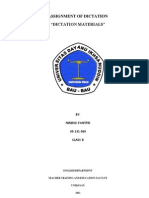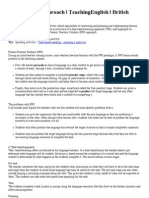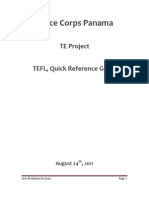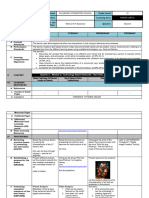Methodology Task-Based Learning
Methodology Task-Based Learning
Uploaded by
mllekiwiCopyright:
Available Formats
Methodology Task-Based Learning
Methodology Task-Based Learning
Uploaded by
mllekiwiOriginal Title
Copyright
Available Formats
Share this document
Did you find this document useful?
Is this content inappropriate?
Copyright:
Available Formats
Methodology Task-Based Learning
Methodology Task-Based Learning
Uploaded by
mllekiwiCopyright:
Available Formats
Onestopenglish | Methodology: task-based learning
30.03.10 15:38
Enter email address
Current Location: Home Teacher Support Ask the experts Methodology
Forgotten password?
Methodology: task-based learning
Author: Scott Thornbury Level: starter/beginner, advanced, elementary, pre-intermediate, intermediate, upperintermediate Type: reference material
An article discussing task-based learning consciousness-raising activities.
I've been looking into TBL recently trying to get the methodology straight before I try it in class. It seems to me that the consciousness / awareness /-raising activities are one of the essential elements of the model (after all that's what makes it a lesson and helps the students to improve). This stage, however, is normally mentioned just in passing without much explanation. Can you please explain what exactly a CR activity is in this situation and how it is different from normal feedback i.e. is it something planned and prepared in advance or is it a direct /spontaneous/ response to spotted mistakes. Dani Zheleva
Answer by Scott Thornbury Answer by Phillip Kerr
Answer 1: Scott Thornbury
The term consciousness-raising (CR) is used to describe how the attention of learners is deliberately directed at features of the language, e.g. grammar or lexis. Its what used to be called presentation. But the term consciousness-raising is now preferred in some quarters, since it credits the learners with some active role in the process of learning, whereas presentation does not. Also, whereas presentation assumed some form of subsequent practice and production (PPP), CR may occur solely at the level of understanding. How does this fit into Task Based Learning? If TBL were simply learning by doing as it was first conceived theres always the risk that some learners wouldnt learn much because they would be so caught up in the doing that they wouldnt notice features of the language being used, or, worse, they would take linguistic short cuts, rely on words rather than grammar etc in short they would take the first steps down the slippery slope of fossilization. Therefore, proponents of TBL Mark 2 recommend that the task sequence include some directed attention on features of the language. That is, CR. Purists argue that this should emerge out of the task and in response to the learners needs and interests. This is what was once known as a test-teach-test instructional cycle. In this sense the teaching stage cannot really be planned although an experienced teacher might well be able to predict it. One way of engineering this stage is: once the students have attempted the task lets say its a ranking task play them a tape of more proficient speakers doing the same task, and let them follow the transcript. Language features can be noted (with or without overt intervention on the part of the teacher), and then appropriated for use in a subsequent re-run of the task, perhaps with different partners. Of course, these stages could be reversed, so that the learners first hear the proficient speakers, note features of the language they use, and then seek to incorporate these features in their own performance. Theres nothing wrong with this, but its hardly TBL in the strict sense of the term. Other ways of engineering a posttask CR stage might be: 1. Record the learners doing the task and then they transcribe all or some of the recording. This often draws attention to features of their output that they might like to modify. They can correct the transcript, and then have an other go at the task. 2. The learners perform a task and then write a summary of what they did. The chance to reflect on their performance may throw up language issues that are then available for discussion with each other and with the teacher. 3. Learners perform the task in pairs, while a third student observes and makes notes. These notes can be framed like this: Did you say? Did you mean? These questions can then be discussed post-task. The students then change roles and repeat the task. 4. Students work in small groups and improvise a conversation, which is recorded, utterance-by-utterance. This is then played back to the class, the teacher pausing the tape strategically, in order to elicit comments from the class. The conversation can also be transcribed on to the board. (This is based on the standard Community Language Learning activity). 5. Learners form groups of three. One learner talks to another for, say, two minutes about a pre-selected topic. The listener then re-tells the speaker as much as he or she can remember, without commenting, interpreting, evaluating, etc. The observer then asks questions to elicit their individual responses to the interaction, and makes comments about anything deemed noteworthy. Out of this retrospection language issues may emerge. Then the
http://www.onestopenglish.com/section.asp?catid=59430&docid=146389 Page 1 sur 3
Onestopenglish | Methodology: task-based learning
30.03.10 15:38
learners switch roles and a new round begins. (This is based on a technique called Non-directive listening). Return to top
Answer 2: Phillip Kerr
Task-based learning (TBL) means different things to different people to such an extent that it normal for writers on the subject to begin their discussion by a definition of what they mean. Rod Elliss recent study (see the suggested reading list below) provides a long and comprehensive description of the various issues and an account of the disagreements as to how we should implement a task-based approach in the classroom. However, most variants of TBL have a number of things in common: They are more interested in the processes of language learning than in the products. Learning a language is seen as being centrally concerned with learning activities, rather than lists of language items to be learnt. They recognize that learning is an unpredictable process and that we cannot assume that students will learn what we teach them. For this reason, they tend to reject any syllabus that is based on lists of grammatical items. They see the main business of acquiring a language as happening while learners are attempting to communicate and deal with meanings.
Consciousness-raising learning
Consciousness-raising (CR) activities draw students attention to language forms (grammatical and lexical patterns, for example) and, as such, are not necessarily oriented towards communication or meaning. CR activities are classroom activities (within a task-based approach) that draw students attentions to the forms of language. There is now a lot of research that suggests that such activities help students to acquire more language more efficiently, but not long ago, many people would have disagreed with you that CR activities were an essential part of a taskbased approach. This may explain why, in some of the literature, references to CR activities is made only in passing or not at all. What exactly is a CR activity? The best way to answer the question is by considering, first of all, what a CR activity is for. Although task-based models reject traditional building-block approaches to language learning (where one structure is taught after another in a predetermined order), they generally accept that students can only benefit from having their attention drawn to features of the language that they might otherwise not notice. This is not to say that students will learn or acquire bits of language to which their attention has been drawn in this way, but the potential for learning is increased if their conscious awareness of language features is raised. Many traditional classroom procedures can act as CR activities, but the teachers objectives will be different in a task-based framework. A simple drill, for example, can be an effective way of raising students awareness of a particular grammatical pattern. In more traditional approaches, a teacher will continue drilling until she feels that students have learnt the language. In a task-based framework, on the other hand, the teacher recognizes that no amount of drilling can ever guarantee that the students will actually learn (i.e. acquire) a particular piece of language. They may be able to reproduce it accurately for a short while, but tomorrow (or next week) is another matter entirely! So a task-based teacher will only continue drilling up to the point where she feels that awareness has been sufficiently raised. This shift in perspective means that CR activities will take place towards the end of the task cycle. CR activities could be done before a communicative task, but the danger here is that the communicative task will become an opportunity for freer practice of a particular language item. In TBL, it is vital that the tasks are centrally concerned with meaning (not particular language items). Once a communicative task has been carried out, a teacher can focus on bits of language without this effecting the task itself. There will obviously be a link between the language that is focused on in CR activities and the language that is needed for the earlier task. We can often predict what sort of language will cause the students problems during a task and we can prepare, in advance, CR activities that will focus on it. However, to some extent, we also need to be ready to respond more spontaneously, because there will always be bits of language that we want to focus on that we havent been able to predict. These wont necessarily be mistakes, either. It may be the case that students have used language perfectly accurately, but in a limited way. CR activities can provide opportunities for students to extend their range, just as much as they can be used to draw attention to error.
Practical suggestions
The simplest way of raising awareness is by providing feedback (e.g. you said X, but you should have said Y). Depending on how it is done, there is nothing wrong with this, but (1) it can be perceived negatively, (2) does not particularly involve the students in the learning process, and (3) tends to become rather repetitive. Jane and Dave Willis, two of the most well-known names in TBL, suggest a much richer menu of CR activities to add to our repertoire. They include the following ideas in their list: 1. Ask students to search a set of data (this could be a text or examples you
http://www.onestopenglish.com/section.asp?catid=59430&docid=146389
Page 2 sur 3
Onestopenglish | Methodology: task-based learning
30.03.10 15:38
have selected yourself) to identify a particular pattern. 2. Ask students to group a set of language examples according to similarities or differences. 3. Give students a generalization about language (a language rule) and ask them to check it against a set of data. 4. Ask students to find similarities or differences between English language patterns and patterns in their own language. 5. Ask students to recall and reconstruct elements of a text that will draw their attention to significant language features.
Further reading
Both of the Willis books in the suggested reading list below give plenty of very concrete examples of such task types. Adopting a TBL approach is hard at the start because we dont always have a repertoire of such activities, but the more you do it, the easier it gets. The two most accessible and practical books on the subject are: Willis, J. & Willis, D. (eds.) (1996), Challenge and Change in Language Teaching. Macmillan (now out of print). Willis, J. (1996), A Framework for Task-Based Learning. Longman Note from editor: Jane and Dave Willis have recently published another book (see below) Willis, D. & Willis, J. (2007), Doing Task-based Teaching. Oxford University Press They have also set up a website which offers articles on task-based teaching and a number of lesson plans: http://www.willis-elt.co.uk/ If you want to read a more academic account of the subject, have a look at: Ellis, R. (2003). Task-based Language Learning and Teaching. Oxford University Press I wish you all the best with your experiment. Whether or not you decide to adopt a full-blooded TBL approach, Im sure that youll enjoy trying it out. Back to Ask the authors | Methodology in Ask the authors
Bookmark with:
Delicious Digg reddit Facebook
What are these? StumbleUpon
http://www.onestopenglish.com/section.asp?catid=59430&docid=146389
Page 3 sur 3
You might also like
- Messaging: beyond a lexical approach in ELTFrom EverandMessaging: beyond a lexical approach in ELTRating: 5 out of 5 stars5/5 (1)
- Have Backbone Disagree and Commit-1Document2 pagesHave Backbone Disagree and Commit-1test100% (2)
- Assignment of Dictation 1Document5 pagesAssignment of Dictation 1Nining SyafitriNo ratings yet
- Pink Bow Tie-Story and PrepDocument2 pagesPink Bow Tie-Story and Prepmllekiwi50% (2)
- Elements of Communicative Learning TaskDocument10 pagesElements of Communicative Learning TaskFernandoOdinDivinaNo ratings yet
- Task-Based LearningDocument9 pagesTask-Based LearningKatherine MondaNo ratings yet
- Teaching Approaches: Task-Based Learning: What Is TBL?Document5 pagesTeaching Approaches: Task-Based Learning: What Is TBL?Abdullah ArslanNo ratings yet
- The 3 Phases in A Communicative Oral TaskDocument6 pagesThe 3 Phases in A Communicative Oral TaskJaqueline FoscariniNo ratings yet
- 3.3 Task-Based Language Teaching (TBLT)Document4 pages3.3 Task-Based Language Teaching (TBLT)Nurul FadilaNo ratings yet
- Teaching Approaches: Task-Based LearningDocument4 pagesTeaching Approaches: Task-Based LearningMushmallow BlueNo ratings yet
- Task-Based Language LearningDocument5 pagesTask-Based Language LearningAnamaria KasunićNo ratings yet
- Lesson ShapesDocument7 pagesLesson ShapesFrancesca MortaraNo ratings yet
- Approches and MethodsDocument5 pagesApproches and MethodsElisaNo ratings yet
- TBL and PBLDocument3 pagesTBL and PBLrayeneNo ratings yet
- Background: Communicative Language Teaching N. Prabhu Bangalore, IndiaDocument43 pagesBackground: Communicative Language Teaching N. Prabhu Bangalore, IndiaAshe LlampaNo ratings yet
- TBL and PBL Two Learner-Centered ApproachesDocument3 pagesTBL and PBL Two Learner-Centered ApproachesnamavayaNo ratings yet
- What Is Task Base LearningDocument3 pagesWhat Is Task Base LearningNoemí Margot Solis LarraínNo ratings yet
- Test 1 AnswerDocument5 pagesTest 1 AnswerBruno CuradoNo ratings yet
- Task Based Learning and Its ExplanationDocument4 pagesTask Based Learning and Its ExplanationSri WirapatniNo ratings yet
- Task Based Learning and Competency BasedDocument17 pagesTask Based Learning and Competency Basedmeymirah100% (1)
- Task-Based Language Teaching and LearningDocument5 pagesTask-Based Language Teaching and LearningKnd LoboNo ratings yet
- TBL and PBLDocument4 pagesTBL and PBLʚϊɞ Sarah Omar ʚϊɞNo ratings yet
- Metode de PredareDocument7 pagesMetode de PredareNicole Vitalariu100% (1)
- Task-Based Approach. Anzid MohammedDocument23 pagesTask-Based Approach. Anzid MohammedAnzid Mohammed100% (1)
- How To Teach Speaking Activities To ESL StudentsDocument3 pagesHow To Teach Speaking Activities To ESL StudentsThias Arisiana100% (2)
- Ken Lack Man Introduction To Task-Based LearningDocument19 pagesKen Lack Man Introduction To Task-Based Learningdspi1No ratings yet
- TBLT Another Acronym?!: ELT PPP ESP TTTDocument2 pagesTBLT Another Acronym?!: ELT PPP ESP TTTClaudio HernándezNo ratings yet
- Arc MethodologyDocument7 pagesArc MethodologyRositaFresitaNo ratings yet
- School Experience 2012-1Document47 pagesSchool Experience 2012-1Andreea BudeanuNo ratings yet
- SorularDocument6 pagesSorulareral427No ratings yet
- Describing Learning and TeachingDocument27 pagesDescribing Learning and TeachingEl Yazid KananeNo ratings yet
- Saya Sedang Berbagi 'PPT Tefl 2' Dengan AndaDocument5 pagesSaya Sedang Berbagi 'PPT Tefl 2' Dengan AndaSilva Noridha SitompulNo ratings yet
- What Is TBL?Document3 pagesWhat Is TBL?Dahian VargasNo ratings yet
- Arizona State University Tesol 1Document6 pagesArizona State University Tesol 1Catarina Niza100% (1)
- A Task-Based Approach - Teachingenglish - British Council - BBCDocument2 pagesA Task-Based Approach - Teachingenglish - British Council - BBCmllekiwiNo ratings yet
- Task Based ApproachDocument4 pagesTask Based ApproachGrisel OleaNo ratings yet
- Eng. 414 Presentation, Task-Based Language Teaching (TBLT)Document10 pagesEng. 414 Presentation, Task-Based Language Teaching (TBLT)Ruthcie Mae D. LateNo ratings yet
- Task and Project Work Apr 12Document50 pagesTask and Project Work Apr 12api-251470476No ratings yet
- Nurmasita Toindeng (A12222023)Document5 pagesNurmasita Toindeng (A12222023)Yudith BadungNo ratings yet
- The Relationship Between Traditional English Grammar Teaching and Communicative Language TeachingDocument4 pagesThe Relationship Between Traditional English Grammar Teaching and Communicative Language TeachingAmeeNo ratings yet
- Planning A Grammar LessonDocument10 pagesPlanning A Grammar LessonDado DodoNo ratings yet
- TBL Grammar Lessons: TrainingDocument9 pagesTBL Grammar Lessons: Trainingemir_ibrahimovicNo ratings yet
- WILLIS The Language Teacher Online 22.07 - Task-Based Learning - What Kind of AdventureDocument5 pagesWILLIS The Language Teacher Online 22.07 - Task-Based Learning - What Kind of AdventurelaukingsNo ratings yet
- m5 ActivitiesDocument6 pagesm5 ActivitiesHải Trà NguyễnNo ratings yet
- A Task-Based LearningDocument4 pagesA Task-Based LearningThao NguyenNo ratings yet
- Task-Based Approach: Present Practice Produce (PPP)Document2 pagesTask-Based Approach: Present Practice Produce (PPP)valhensNo ratings yet
- FP011TP ActPract CO en-JZamoraDocument7 pagesFP011TP ActPract CO en-JZamoraJulia ZamoraNo ratings yet
- Task Based ApproachDocument3 pagesTask Based ApproachTina Galgotia100% (1)
- StrategyDocument15 pagesStrategyhagerelbatawy2No ratings yet
- Glossary of ELT Terms: AccuracyDocument4 pagesGlossary of ELT Terms: AccuracyBrodaricaNo ratings yet
- CLILSkills .En (126-238)Document113 pagesCLILSkills .En (126-238)Bulatova ViktoriaNo ratings yet
- Summarizing Book Chapters 13Document6 pagesSummarizing Book Chapters 13Lifyan AriefNo ratings yet
- LTM 1Document10 pagesLTM 1Aas Yulia DasirNo ratings yet
- ELT-ESP JSP Chapter 1 FinalDocument10 pagesELT-ESP JSP Chapter 1 FinalagalyaNo ratings yet
- Making Efl Learners Into Independent Vocabulary UsersDocument8 pagesMaking Efl Learners Into Independent Vocabulary Userssivi6194No ratings yet
- Should We Teach Grammar?Document8 pagesShould We Teach Grammar?southerland joanneNo ratings yet
- What Is DictationDocument9 pagesWhat Is DictationBryan AndrewNo ratings yet
- Teaching EFL Quick GuideDocument75 pagesTeaching EFL Quick GuideJose Batista De LeónNo ratings yet
- Communicative Approach: An Introduction To The Communicative ClassroomDocument10 pagesCommunicative Approach: An Introduction To The Communicative ClassroomZeynabNo ratings yet
- Task Based Language TeachingDocument13 pagesTask Based Language TeachingSupansa SirikulNo ratings yet
- Chain Reaction-Story and PrepDocument2 pagesChain Reaction-Story and PrepmllekiwiNo ratings yet
- Genie-Us: Short Stories and Poems - Answers: 1. Preparation: MatchingDocument1 pageGenie-Us: Short Stories and Poems - Answers: 1. Preparation: MatchingmllekiwiNo ratings yet
- Genie Us Exercises 1Document2 pagesGenie Us Exercises 1mllekiwiNo ratings yet
- Genie Us Story and Prep 1Document2 pagesGenie Us Story and Prep 1mllekiwiNo ratings yet
- Pink Bow Tie-Story OnlyDocument2 pagesPink Bow Tie-Story Onlymllekiwi100% (5)
- Summary of Principles in Language Teaching - FlickDocument2 pagesSummary of Principles in Language Teaching - FlickmllekiwiNo ratings yet
- A Task-Based Approach - Teachingenglish - British Council - BBCDocument2 pagesA Task-Based Approach - Teachingenglish - British Council - BBCmllekiwiNo ratings yet
- Content-Based Second Language Instruction: What Is It?: Origins and DefinitionsDocument6 pagesContent-Based Second Language Instruction: What Is It?: Origins and DefinitionsmllekiwiNo ratings yet
- The Life of Pi Level 3-Text and Prep 0 PDFDocument2 pagesThe Life of Pi Level 3-Text and Prep 0 PDFmllekiwiNo ratings yet
- Christmas Worksheets MaryglasgowDocument3 pagesChristmas Worksheets Maryglasgowmllekiwi100% (4)
- ORLADocument10 pagesORLACarol CoelhoNo ratings yet
- Past Simple PassiveDocument3 pagesPast Simple PassiveAyu Kurnia100% (1)
- JSS Hughes Davis Imenda2019Document13 pagesJSS Hughes Davis Imenda2019John Raizen Grutas CelestinoNo ratings yet
- Q2 DLL Arts10 Week2 5Document5 pagesQ2 DLL Arts10 Week2 5Kristine Joy Tabastabas MayrinaNo ratings yet
- Lecture-Notes 2 CADDocument10 pagesLecture-Notes 2 CADJomar MendrosNo ratings yet
- Go For A Walk To Get Creative British English StudentDocument4 pagesGo For A Walk To Get Creative British English StudentGuadalupe LimasNo ratings yet
- Dyslexia Toolkit: A Resource For Students and Their TutorsDocument85 pagesDyslexia Toolkit: A Resource For Students and Their TutorsElena Markovic100% (1)
- Gapped TextsDocument2 pagesGapped TextsGigi GuastellaNo ratings yet
- Lerroc Exam 1Document12 pagesLerroc Exam 1John LouiseNo ratings yet
- Theories and Practice of Translation BT Modoficat 27 11 2006 PDFDocument248 pagesTheories and Practice of Translation BT Modoficat 27 11 2006 PDFTassos Iliadis100% (2)
- Free Download Ebook of Vocabulary With Mnemonics by Virender MehtaDocument20 pagesFree Download Ebook of Vocabulary With Mnemonics by Virender Mehtavirendermehta100% (2)
- The Integrated Performance Assessment (IPA) Connecting Assessment To Instruction and LearningDocument24 pagesThe Integrated Performance Assessment (IPA) Connecting Assessment To Instruction and LearningMatt Chen100% (1)
- All in SAMDocument6 pagesAll in SAM1286313960No ratings yet
- A Funeral in The Public Service Center 1Document4 pagesA Funeral in The Public Service Center 1Bernard KwarahNo ratings yet
- Developing Metacognition (INDUS)Document4 pagesDeveloping Metacognition (INDUS)BuhariNo ratings yet
- Review Article Recent Advances in ArtifiDocument14 pagesReview Article Recent Advances in ArtifiRicard MejíaNo ratings yet
- Begae 182Document4 pagesBegae 182Ashish AroraNo ratings yet
- Pref - 5 - Grammar 3.5 - Revisión Del IntentoDocument5 pagesPref - 5 - Grammar 3.5 - Revisión Del IntentoGamerMExXNo ratings yet
- Planner Profile Kevin Andrew LynchDocument12 pagesPlanner Profile Kevin Andrew LynchVedant MahajanNo ratings yet
- Teaching PronunciationDocument2 pagesTeaching PronunciationSmile EnglishNo ratings yet
- Classroom For Beginner English StudentsDocument65 pagesClassroom For Beginner English Studentsanna peterson100% (1)
- Training DesignDocument5 pagesTraining DesignpraveenbgmNo ratings yet
- Philosophy of Education Action PlanDocument5 pagesPhilosophy of Education Action PlanDonnie Elder III100% (1)
- Literary Biomimesis - Mirror Neurons and The Ontological Priority of Representation, Jensen & IacoboniDocument18 pagesLiterary Biomimesis - Mirror Neurons and The Ontological Priority of Representation, Jensen & IacobonibenhjorthNo ratings yet
- An Introduction To Self and Peer AssessmentDocument22 pagesAn Introduction To Self and Peer AssessmentDavid JenningsNo ratings yet
- R20 CS Draft v0.0Document5 pagesR20 CS Draft v0.0Keerthi VarmanNo ratings yet
- The Literature Review: Leeanne Romane, Computer Science Librarian University of Waterloo October 8, 2008Document17 pagesThe Literature Review: Leeanne Romane, Computer Science Librarian University of Waterloo October 8, 2008Rangothri Sreenivasa SubramanyamNo ratings yet
- Unit 11 Official Guide SheetDocument9 pagesUnit 11 Official Guide SheetHalima AhmedNo ratings yet
- Luan An Thac Sy Tieng Anh Role PlayDocument69 pagesLuan An Thac Sy Tieng Anh Role PlayhoasachNo ratings yet



































































































